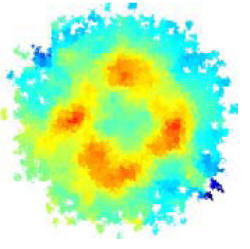Soft Condensed Matter
Surface, interfacial and bulk properties of complex fluids (polymers, surfactants, colloids).
-
Interfacial studies: self-assembly and ordering of complex mixtures of surfactants, polymers and proteins at interfaces, with emphasis on kinetic processes and multi-component systems at technologically relevant interfaces (liquid-liquid and liquid-solid), thin film devices.
-
Processing of soft solids: relationship between microscopic structure and bulk properties (rheology) in industrially relevant fluid fields.
-
Self-assembly: structure of lyotropic mesophases, micro-emulsions and vesicles, with emphasis on dynamics of structural phase changes, association and disassociation, and self-assembly in super-critical fluids.
-
In-situ electrochemistry.
Bio-molecular Sciences
Pharmaceuticals, drug delivery formulations, membrane-protein interactions, bio-compatibility and functionality, food technology.
- Interfaces and membranes: structural organisation of membranes and membrane-protein systems.
-
Macromolecular assemblies: low resolution studies on macromolecular assemblies, in systems not tractable by high resolution crystallography, viruses, glyco-proteins, protein folding, protein-nucleic acid interactions. Solvent structure. Meso-scale structure.
-
Pharmaceuticals: determination of new drug structures, where the role of hydrogen atoms is essential in understanding drug-receptor interactions. Molecular engineering.
-
Food technology: study of solvent distribution and structural changes in complex assemblies (for example starches) during processing. Protein fouling. Protein adsorption and colloidal stability. Mechanism of foam and gel formation.
Advanced Materials
Crystalline, magnetic, disordered and engineering materials, including complex inorganic and organic assemblies, clathrates, intercalates, zeolites, nano-structured materials, high temperature superconductors, giant magneto-resistance materials, magnetic films and multi-layers, spin valves, glasses, complex fluids, porous media.

Spin fluctuations in high temperature superconductor
-
Structural details of giant/colossal magnetoresistive materials, non-stoichiometric oxides, piezoelectric, ferroelectric and negative thermal expansion materials.
-
Composite multi-crystalline materials, such as mixed geological phases, magnetoresistive manganates, toughened engineering materials and high-temperature superconductors.
-
Studies under extreme conditions, catalysis, in-situ chemical reactions (including electrochemistry and battery function), ultra-high pressures, novel processing routes.
-
Structure of nano-scale materials, sol-gel processing, ceramics.
-
Structure of complex materials: role of zeolites in ion exchange materials and catalysis, novel electrodes and electrolytes, clathrate formation, nano-structured materials
-
Determination of new magnetic structures: materials with novel ground states.
-
Magnetic thin films, multilayers, spin electronics.
-
Nucleation and growth processes, molecular clustering, glasses.
-
Complex fluids in porous media; oil recovery; waste disposal; supercritical fluids.
-
Stress/strain mapping in engineering materials.
